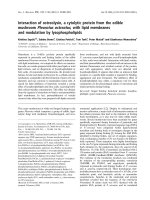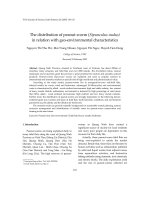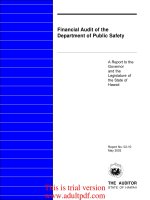Distribution of secretory phopholipase group XIIA in the CNS and its role in lipid metabolism and cognition
Bạn đang xem bản rút gọn của tài liệu. Xem và tải ngay bản đầy đủ của tài liệu tại đây (15.47 MB, 134 trang )
Distribution of Secretory Phospholipase Group XIIA in the CNS
and its Role in Lipid Metabolism and Cognition
EE SZE MIN
(B.Sc. (Hons), NUS)
SUPERVISOR: ASSOCIATE PROFESSOR LO YEW LONG
A THESIS SUBMITTED FOR THE DEGREE OF
MASTER OF SCIENCE
DEPARTMENT OF ANATOMY
YONG LOO LIN SCHOOL OF MEDICINE
NATIONAL UNIVERSITY OF SINGAPORE
2013
Declaration
DECLARATION
I hereby declare that the thesis is my original work
and it has been written by me in its entirety.
I have duly acknowledged all the sources of
information which have been used in the thesis.
This thesis has also not been submitted for any
degree in any university previously.
_______________________
Ee Sze Min
14 January 2013
I
Acknowledgements
ACKNOWLEDGEMENTS
I wish to express my deepest appreciation and gratitude to my two
supervisors, Associate Professor Lo Yew Long, Department of Anatomy,
National University of Singapore, who extended utmost support to my entire
project; to my co-supervisor, Associate Professor Ong Wei Yi, Department of
Anatomy, National University of Singapore, for suggesting this study, and for his
patient guidance and encouragement throughout the course of the study. His
immense patience, enthusiasm and stimulating discussion have been invaluable
in the accomplishment of this thesis.
I would like to express my appreciation to all staff members and fellow
postgraduate students in the Histology Laboratory, Neurobiology Programme,
Centre for Life Sciences and Anatomy Department who have help me in one way
of another - Miss Chan Yee Gek and Mdm Wu Ya Jun for their assistance in
electron microscopy and Mdm Ang Lye Gek Carolyne, Mdm Teo Li Ching
Violet and Mdm Dilijit Kour D/O Bachan Singh for their secretarial assistance.
I would also like to extend my appreciation to my fellow colleagues in the lab,
Chew Wee Siong, Chia Wan Jie, Kazuhiro Tanaka, Kim Ji Hyun, Lee Hui
Wen Lynette, Loke Sau Yeen, Ma May Thu, Ng Pei Ern Mary, Poh Kay Wee,
Tan Yan, Yang Hui and Yap Mei Yi Alicia for their contributions to make this
project successful. I would also like to thank Associate Professor Markus R.
Wenk and Dr. Shui Guanghou for their support in lipidomic analysis.
II
Table of Contents
TABLE OF CONTENTS
CONTENTS
PAGE
Declaration Page
I
Acknowledgements
II
Table of Contents
III
Summary
VII
List of Tables
IX
List of Figures
X
Abbreviations
XII
SECTION I - INTRODUCTION
1
1.0
Phospholipase A2
2
1.1
Cytosolic Phospholipase A2
4
1.2
Calcium Independent Phospholipase A2
5
1.3
Secretory Phospholipase A2
6
1.3.1
sPLA2-IB
9
1.3.2
sPLA2-IIA
10
1.3.3
sPLA2-IIC
11
1.3.4
sPLA2-IID
11
1.3.5
sPLA2-IIE
12
1.3.6
sPLA2-IIF
12
1.3.7
sPLA2-III
13
1.3.8
sPLA2-V
14
1.3.9
sPLA2-X
15
1.4
1.3.10 sPLA2-XIIA
15
1.3.11 sPLA2-XIIB
17
PLA2 Function in the Brain
18
1.4.1
19
Neurotransmitter Release
III
Table of Contents
1.4.2
Long-Term Potentiation
20
1.4.3
Membrane Repair
21
1.4.4
Neurite Outgrowth and Regeneration
22
1.4.5
Inflammatory and Anti-Inflammatory Processes
23
1.4.6
Neurodegeneration
23
1.5
Arachidonic Acid in the Brain
24
1.6
PLA2 Receptors
26
1.7
Aims of the present study
27
SECTION II – EXPERIMENTAL STUDY
28
CHAPTER 1 – EXPRESSION PROFILE OF VARIOUS PLA2
ISOFORMS IN THE CNS
2.1.1 Introduction
29
2.1.2
2.1.3
2.1.4
30
Materials and Methods
32
2.1.2.1
Real-Time PCR
32
2.1.2.2
Western Blot Analyses
33
Results
35
2.1.3.1
Differential Expression of sPLA2-XIIA mRNA in
the CNS
35
2.1.3.2
Differential Expression of PLA2 Isoforms in the
Prefrontal Cortex
36
2.1.3.3
Differential Expression of PLA2 Isoforms in the
Hippocampus
37
2.1.3.4
Western Blot Analyses of sPLA2-XIIA Protein
Expression in the Brain
38
Discussion
CHAPTER 2 – LOCALIZATION OF GROUP XIIA sPLA2 IN VARIOUS
REGIONS OF THE BRAIN
41
43
2.2.1
Introduction
44
2.2.2
Materials and Methods
46
2.2.2.1
46
Immunohistochemistry
IV
Table of Contents
2.2.2.2
Electron Microscopy
2.2.3 Results
46
48
2.2.3.1
sPLA2-XIIA Localization in Forebrain under
Light Microscopy
48
2.2.3.2
sPLA2-XIIA Localization in Hindbrain under
Light Microscopy
sPLA2-XIIA Localization in the Cortex under
Electron Microscopy
49
2.2.3.3
2.2.4 Discussion
51
52
CHAPTER 3 – CHANGES IN PREFRONTAL CORTICAL LIPID
PROFILE OF GROUP XIIA sPLA2 KNOCKDOWN
RATS
2.3.1 Introduction
2.3.2 Materials and Methods
55
56
59
2.3.2.1
Intracortical Injection of Antisense Locked
Nucleic Acid
59
2.3.2.2
Western Blot to show Knockdown of sPLA2-XIIA
59
2.3.2.3
Lipid Extraction
60
2.3.2.4
Lipid Analyses using Liquid
Chromatography/Mass Spectrometry
60
2.3.3 Results
62
2.3.3.1
Western Blot Analyses of Antisense LNA
Injected Rats
62
2.3.3.2
Lipidomic Analyses
64
2.3.3.2.1
Phosphatidic Acid
66
2.3.3.2.2
Phosphatidylcholine and
Lysophosphatidylcholine
67
2.3.3.2.3
Phosphatidylethanolamine and
Lysophosphatidylethanolamine
69
2.3.3.2.4
Phosphatidylinositol and
Lysophosphatidylinositol
71
2.3.3.2.5
Phosphatidylserine and
Lysophosphatidylserine
72
2.3.3.2.6
Sphingolipid and Sphingomyelin
73
V
Table of Contents
2.3.3.2.7
Ceramide and Glucosyl-Ceramide
74
2.3.3.2.8
Gangliosides
75
2.3.4 Discussion
CHAPTER 4 – FUNCTIONAL STUDIES OF GROUP XIIA sPLA2 IN
KNOCKDOWN RATS
76
78
2.4.1 Introduction
79
2.4.2 Materials and Methods
82
2.4.2.1
Attentional Set-Shifting Task
82
2.4.2.2
Passive Avoidance
85
2.4.3 Results
86
2.4.3.1
Attentional Set-Shifting Task
86
2.4.3.2
Passive Avoidance
88
2.4.4 Discussion
90
SECTION III - CONCLUSION
93
SECTION IV – FUTURE STUDIES
97
SECTION V - REFERENCES
99
VI
Summary
SUMMARY
Phospholipases A2 (PLA2) catalyze the hydrolysis of membrane
phospholipids to produce free fatty acids and lysophospholipids, which have
important functions in cell signaling. To date, however, little is known about
differential expression and physiological functions of PLA2 isoforms in specific
brain regions. The present study was carried out to determine differential
expression of PLA2 isoforms in the prefrontal cortex (PFC) of the rat brain. Real
time RT-PCR results indicated that sPLA2-XIIA had greater mRNA expression
than iPLA2-VI or cPLA2-IVA in all brain regions, or compared to other sPLA2
isoforms, in the PFC and hippocampus. Western blots showed a 24kDa band in
different regions of the adult brain, and high levels of sPLA2-XIIA protein
expression were detected in the PFC, striatum and thalamus. The enzyme was
immunolocalized to neurons, and electron microscopy showed that sPLA2-XIIA is
present in axon pre-terminals or growth cones that did not form synaptic contacts
with dendrites. Injection of antisense oligonucleotide to sPLA2-XIIA in the PFC
resulted in increases in phospholipid but decreases in lysophospholipid
molecular species, consistent with decreased catalytic activity of the enzyme,
and alterations in sphingolipids. sPLA2-XIIA knockdown also resulted in shorter
latency timings in the passive avoidance test, and higher number of errors in the
attention set-shifting task, indicating deficits in working memory and attention,
respectively. Together the results show an important role of sPLA2-XIIA in lipid
metabolism and cognition. We postulate that sPLA2-XIIA may induce remodeling
VII
Summary
of opposing neural cell membranes to facilitate axon pathfinding and neural
plasticity in the brain.
VIII
List of Tables
LIST OF TABLES
TABLE
PAGE
Table 1.3
Phenotypes of transgenic and knockout mice
9
Table 2.3.3.2
Lipid species that displayed significant changes
between antisense and sense LNA injected rats
66
Table 2.4.2.1
Descriptions of stages within the Attentional SetShifting Task
85
IX
List of Figures
LIST OF FIGURES
FIGURE
PAGE
SECTION I
Figure 1.0
Sites of action of different phospholipase classes
2
Figure 1.3.1
Sequence identity dedrogram of mouse and
human sPLA2
7
Figure 1.3.2
Schematic structure of mammalian sPLA2 isoforms
7
Figure 1.3.10
Alignment of mouse, rat and human group XIIA
sPLA2 using ClustalW
16
Figure 2.1.3.1
Real-time RT-PCR analyses of sPLA2-XIIA, cPLA2IVA and iPLA2-VI mRNA distribution in various
parts of the rat brain
37
Figure 2.1.3.2
Real-time RT-PCR analyses of sPLA2, cPLA2,
iPLA2 isoforms in the prefrontal cortex
38
Figure 2.1.3.3
Real-time RT-PCR analyses of sPLA2, cPLA2,
iPLA2 isoforms in the hippocampus
39
Figure 2.1.3.4
Immunoblot of adult Wistar rats in various parts of
the rat brain
Figure 2.2.3.1
Light micrographs of sPLA2-XIIA immunoreactive
brain slices in the forebrain
50
Figure 2.2.3.2
Light micrographs of sPLA2-XIIA immunoreactive
brain slices in the cerebellum, brain stem and
spinal cord
51
Figure 2.2.3.3
Electron micrograph of sPLA2-XIIA immunoreactive
sections from the prefrontal cortex
53
Figure 2.3.1.1
Breakdown of glycerophospholipid to yield
arachidonic acid and lysophospholipid
58
SECTION II
40-41
X
List of Figures
Figure 2.3.1.2
Metabolism of sphingomyelin and sphingolipids
59
Figure 2.3.3.1
Western blots analyses of rats injected
intracortically with sPLA2-XIIA antisense and sense
LNA
64
Figure 2.3.3.2.1
Relative abundances of Phosphatidic Acid in the
prefrontal cortex of antisense LNA and sense
injected rats
68
Figure 2.3.3.2.2
Relative abundances of Phosphatidylcholine and
Lysophosphatidylcholine in the prefrontal cortex of
antisense LNA and sense injected rats.
69-70
Figure 2.3.3.2.3
Relative abundances of Phosphatidylethanolamine
and Lysophosphatidylethanolamine in the
prefrontal cortex of antisense LNA and sense
injected rats
71-72
Figure 2.3.3.2.4
Relative abundances of Phosphatidylinositol and
Lysophosphatidylinositol in the prefrontal cortex of
antisense LNA and sense injected rats
73
Figure 2.3.3.2.5
Relative abundances of Phosphatidylserine and
Lysophosphatidylserine in the prefrontal cortex of
antisense LNA and sense injected rats
74
Figure 2.3.3.2.6
Relative abundances of Sphingolipid and
Sphingomyelin in the prefrontal cortex of antisense
LNA and sense injected rats
75
Figure 2.3.3.2.7
Relative abundances of Ceramide and Glucosyl
Ceramide in the prefrontal cortex of antisense LNA
and sense injected rats
76
Figure 2.3.3.2.8
Relative abundances of Gangliosides in the
prefrontal cortex of antisense LNA and sense
injected rats
77
Figure 2.4.3.1
Number of trials required to achieve 6 consecutive
success and number of errors made during
Attentional Set Shifting Task procedure
88
Figure 2.4.3.2
Passive avoidance performance of sPLA2-XIIA
antisense and sense LNA injected rats 1 hour and
24 hours after training
90
XI
Abbreviations
ABBREVIATIONS
AA
Arachidonic acid
ADHD
Attention Deficit/Hyperactivity Disorder
AMPA
2-amino-3-(5-methyl-3-oxo-1,2-oxazol-4yl) propanoic acid
ASST
Attentional set shifting task
ATP
Adenosine triphosphate
Bcl-2
B-cell lymphoma 2
BEL
Bromoenol lactone
Ca2+
Calcium
CD
Compound discrimination
CDR
Compound discrimination reversal
CD4
Cluster of differentiation 4
Cer
Ceramide
CNS
Central nervous system
COX
Cyclooxygenase
cPLA2
Calcium-dependent cytosolic phospholipase A2
Cys
Cysteine
DAB
3,3-diaminobenzidine tetrahydrochloride
DHA
Docosahexaenoic acid
DNA
Deoxyribonucleic acid
EDR
Extradimensional reversal
EDS
Extradimensional shift
XII
Abbreviations
GluCer
Glucosylceramide
GluR
Glutamate receptor
GM3
Ganglioside 3
GPCR
G-protein-coupled receptor
HPLC
High performance liquid chromatography
HSPG
Heparin sulfate proteoglycan
IDR
Intradimensional reversal
IDS
Intradimensional shift
IL
Interleukin
iPLA2
Calcium-independent phospholipase A2
LNA
Locked nucleic acid
LTD
Long-term depression
LTP
Long-term potentiation
LysoPC
Lysophosphatidylcholine
LysoPE
Lysophosphatidylethanolamine
LysoPI
Lysophosphatidylinositol
LysoPS
Lysophosphatidylserine
MAPK
Mitogen-activated protein kinase
mM
Millimolar
NMDA
N-methyl-D-aspartic acid
PA
Phosphatidic acid
PAF
Platelet-activating factor
PBS
Phosphate-buffered saline
XIII
Abbreviations
PC
Phosphatidylcholine
PC12
Pheochromocytoma 12
PCR
Polymerase chain reaction
PE
Phosphatidylethanolamine
PFC
Prefrontal Cortex
PG
Phosphatidylglycerol
PI
Phosphatidylinositol
PKC
Protein kinase C
PLA1
Phospholipase A1
PLA2
Phospholipase A2
PLC
Phospholipase C
PS
Phosphatidylserine
PUFA
Polyunsaturated fatty acids
PVDF
Polyvinylidene difluoride
RNA
Ribonucleic acid
ROS
Reactive oxygen species
SD
Simple discrimination
Ser
Serine
siRNA
Small interfering ribonucleic acid
SL
Sphingolipid
SM
Sphingomyelin
sPLA2
Secretory phospholipase A2
TBS
Tris-buffered saline
XIV
Section II
Aims of the present study
SECTION I
INTRODUCTION
1
Section II
Aims of the present study
1.
Phospholipase A2
Phospholipase A2 (PLA2; EC 3.1.1.4) is a family of lipolytic enzymes that
catalyzes the hydrolysis of glycerophospholipids at the sn
sn-2
2 position (Figure 1.0)
to liberate arachidonic acid (AA) and lysophospholipids (Farooqui
Farooqui and Horrocks,
2004; Titsworth et al., 2008
2008). Four major classes of PLA2 have been identified –
cytosolic PLA2 (cPLA2), secretory PLA2 (sPLA2) and calcium-independent
independent PLA2
(iPLA2) and plasmalogen
plasmalogen-selective PLA2 (PlsEtn-selective
selective PLA2). 10 different
isoforms of sPLA2 (IB, IIA, IIC, IID, IIE, IIF, III, V, X and XII) with molecular sizes
ranging from 14-19kDa,
19kDa, have been identified in the brain (Valentin
Valentin and Lambeau,
2000). The cPLA2 family consist 6 different enzym
enzymes which has an N-terminal
N
C2
domain that allows for its association with cellular membranes (Kita
Kita et al., 2006)
2006
while the iPLA2 family is made up of 9 different enzym
enzymes.
Figure 1.0. Sites of action of different phospholipase classes. PLA1 cleaves at the sn-1 position,
PLA2 cleaves at the sn-2
2 position releasing arachidonic acid, PLC cleaves before the phosphate
releasing diacylglycerol and PLD cleaves after the phosphate group releasing phosphatidic acid
and alcohol as its products.
2
Section II
Aims of the present study
The structural diversities between these classes of PLA2 indicate that its
involvement in various biochemical processes and plays functional roles in both
physiological and pathological conditions. The functionalities of each PLA2 class
is dependent on its pathway of activation and cellular localization (Zhu et al.,
1996). The main metabolite, arachidonic acid (AA), can be modified into
eicosanoids via the action of cyclooxygenases, thereby releasing inflammatory
regulators such as prostaglandins and leukotrienes (Dennis, 1994). On the other
hand,
phospholipids
including
phosphatiylcholine
(PC),
phosphatidylethanolamine (PE), phosphatidylinositol (PI) and phosphatidylserine
(PS) are hydrolyzed into its respective lysophospholipid species (Farooqui et al.,
2000a). These lysophospholipids are transient metabolic intermediates produced
during membrane remodeling (Farooqui et al., 2000b). Lysophospholipids form
micelles when present at low concentrations and tends to aggregate into
cylindrical hexagonal phases at higher concentrations. Such aggregations are
thought to alter membrane structures and ion-gated channels (Lundbaek and
Andersen, 1994) by forming dimeric open channels. Therefore, regulation of
PLA2
action
is
important
to
maintain
basal
levels
of
AA
and
lysoglycerophospholipids for normal brain function. In normal circumstances,
fatty acids would be recycled by a deacylation/reacylation pathway to maintain its
concentration in cells (Farooqui et al., 2000b). However under pathological
conditions, a highly active PLA2 has been reported to cause the loss of neural
glycerophospholipids, thereby affecting membrane fluidity and permeability. In
3
Section II
Aims of the present study
addition, the accumulation of lipid peroxides and free radicals may lead to the
onset of neurodegenerative diseases (Farooqui and Horrocks, 1994).
1.1
Cytosolic Phospholipase A2
The intracellular cPLA2 family has a typical molecular weight of 85 kDa
that is characterized by its C2 domain at the N-terminal region. It is found highly
expressed in the central nervous system (CNS) with the hindbrain showing high
cPLA2 activity (Ong et al., 1999). Similarly, abundant expression of cPLA2 mRNA
was also observed in most brain regions, with high expression in the pineal gland
and pons (Kishimoto et al., 1999). Three paralogs of cPLA2 - cPLA2-α (Mr = 85
kDa), cPLA2-β (Mr = 114 kDa) and cPLA2-γ (Mr = 61 kDa) are present in the brain
and non neural tissues. cPLA2-α is pre-dominantly localized in the astrocytes
(Stephenson et al., 1994) and post-synaptic dendrites to unlabeled axon
terminals (Ong et al., 1999). The enzyme has high binding affinity to AA at the
sn-2 position and does not require Ca2+ for catalysis although submicromolar
Ca2+ is required for its translocation from the cytosol to membrane for binding
purposes (Kramer and Sharp, 1997). Catalysis of glycerophospholipid is then
facilitated by the C-terminus region of cPLA2-α mRNA which contains both the
phosphorylation and catalytic sites. On the contrary, cPLA2-β and cPLA2-γ are
more likely to target fatty acids at the sn-1 position (Song et al., 1999) and
function at a lower rate than cPLA2-α. However, as compared to cPLA2-α,
relatively little is known about the functions of cPLA2-β and cPLA2-γ till date.
4
Section II
Aims of the present study
Thus, the differential targets of cPLA2 serve to ensure that AA is released
efficiency during receptor activation and signal transduction processes.
1.2
Calcium Independent Phospholipase A2
The iPLA2 family is a Ca2+-independent phospholipase that has a typical
molecular weight of 80 kDa. Two distinct members of iPLA2 includes iPLA2-VIA
and iPLA2-VIB. iPLA2-VIA is conserved with iPLA2-VIB at the C-terminus but
shares little homology at the N-terminus region. Different iPLA2 isoforms that
have specific tissue localization and functions are generated via alternative
splicing (Larsson et al., 1998). iPLA2-VI is the highest expressing PLA2 isoform in
the brain (Molloy et al., 1998; Yang et al., 1999b; Yang et al., 1999a) and its
protein expression decreases during aging (Aid and Bosetti, 2007). It is present
in all brain regions, with high expression found in rat’s striatum, hypothalamus
and hippocampus (Molloy et al., 1998). In the monkey brain, iPLA2
immunolabeling was generally observed in the telencephalon including the
cerebral cortex, septum, amygdala and striatum while the diencephalon which
includes the thalamus, hypothalamus and subthalamic nucleus are lightly stained
(Ong et al., 2005). At electron microscopy, immunoreactivity was observed in the
neuronal nuclei and axon terminals. iPLA2 activity could be investigated via the
use of a specific inhibitor, bromoenol lactone (BEL) (Ackermann et al., 1995).
However,
it
is
difficult
to
determine
the
specific
role
of
iPLA2
in
glycerophospholipid metabolism as BEL also acts on and inhibits other enzymes
such as phosphatidate phosphohydrolase (Fuentes et al., 2003). It was found
5
Section II
Aims of the present study
that iPLA2 play significant functions in long-term potentiation (LTP), long-term
depression (LTD), neural cell proliferation, apoptosis and differentiation (Akiba
and Sato, 2004; Farooqui et al., 2004).
1.3
Secretory Phospholipase A2
Ten different isoforms of sPLA2 (IB, IIA, IIC, IID, IIE, IIF, III, V, X and XII),
with molecular sizes ranging from 14-19kDa, had been identified in the brain. The
isoforms are highly conserved with a Ca2+ binding loop (XCGXGG) and catalytic
site (DXCCXXHD) domain (Titsworth et al., 2008). Stability of the enzymes is
maintained by 6 disulfide bonds and 2 additional unique disulfide bonds which
are suggested to protect them from thermal and chemical denaturation
(Schulenburg et al., 2010). sPLA2 can be further divided into three major
subgroups – conventional I/II/V/X sPLA2 and, atypical group III and XII sPLA2
(Figure 1.3.1) (Murakami et al., 2010). Genes encoding for sPLA2-IIA, -IIC, -IID, IIE, -IIF and –V occupy the same chromosome locus and are therefore referred
collectively as group II subfamily sPLA2 (Valentin et al., 2000). The atypical
sPLA2-III and sPLA2-XIIA/XIIB possess poor homology against the conventional
I/II/V/X sPLA2 with the exception of the Ca2+ binding domain and catalytic site
(Figure 1.3.2) (Murakami et al., 2011). Each sPLA2 has its unique enzymatic
properties and localization suggesting distinct pathophysiological roles in
mammalian system (Lambeau and Gelb, 2008). Activation of substrate hydrolysis
occurs via hydrogen bonding of water molecules to the histidine active site.
6
Section II
Aims of the present study
Figure 1.3.1. Sequence identity dedrogram of mouse and human sPLA2 that was aligned using
ClustalW and dendrogram generated with Treeview. Dendrogram shows three major groups of
sPLA2 – Group I/II/V/X sPLA2, Group III sPLA2 and Group XII sPLA2 [Adapted from (Murakami
et al., 2010)]
Figure 1.3.2. Schematic structure of mammalian sPLA2 isoforms. All sPLA2 have conserved
2+
Ca binding loops and catalytic site, with the exception of sPLA2-XIIB that has a mutation in
the catalytic site. sPLA2-III has an unique N- and C- terminus domain that appears to be
removed in vivo [Adapted from (Murakami et al., 2010)]
7
Section II
Aims of the present study
The interaction is facilitated by a ligand cage that comprises an adjacent
aspartate residue and Ca2+ binding loop (Masuda et al., 2005a).
sPLA2 enzymes are able to exert its functions via several different
mechanisms. Firstly, sPLA2 possess a secretory signal that requires high
concentration of Ca2+ to carry out secretion in cells (Murakami et al., 2010). Thus,
the primary target of sPLA2 is postulated to reside in extracellular spaces.
Studies have proven that the enzyme is indeed versatile and able to interact with
numerous targets in extracellular spaces. Secondly, sPLA2 can also act on
phospholipids of intracellular vesicles, exosomes, lipoproteins and foreign
microbial membranes (Fourcade et al., 1995; Hanasaki et al., 2002). Lastly,
sPLA2 may also exhibit their functions via receptors or its binding partners that is
independent of its enzymatic properties (Lambeau and Lazdunski, 1999;
Pungercar and Krizaj, 2007).
The physiological and pathological functions of sPLA2 have been
investigated and identified using gene-manipulated mice (Table 1.3). Transgenic
overexpression and knockout models of sPLA2 in tissues can provide informative
hints and evidences for its potential functions in vivo based on their differential
expression locations. Till date, only a few sPLA2 isoforms have been well studied
while distinct information are still missing for other isoforms including sPLA2-IIC,
sPLA2-IID, sPLA2IIE, sPLA2-IIF, sPLA2-XIIA and sPLA2-XIIB. Therefore, given
sPLA2 significance in lipid metabolism in cells, the analysis of all sPLA2 isoforms
should provide answers regarding the biological functions of each individual
sPLA2.
8
Section II
Aims of the present study
Table 1.3: Phenotypes of transgenic and knockout mice
sPLA2 Isoform
Phenotypes in Tg mice
IB
Unknown
IIA
Diet induced atherosclerosis
Protection from bacterial
infection and colorectal
polyposis
Diet induced atherosclerosis
Systemic inflammation
Lung dysfunction
III
V
X
Lung defect
Decrease lipoproteins
Phenotype of knockout
mice
Reduction in phospholipid
digestion in dietary tract
Increased colorectal
polyposis
Unknown
Reduced eicosanoid
production
Protection for Candida
albicans infection
Reduced LPS-induced lung
injury
Reduced allergen induced
asthma
Reduced myocardial injury
1.3.1 sPLA2-IB
sPLA2-IB is a pancreatic-type PLA2 that has an unique loop of five amino
acids and a group I specific disulfide bond between Cys11 and Cys77 (Seilhamer
et al., 1986). It is synthesized in the pancreatic acinar cells as a zymogen with
the N-terminal peptide trypsin cleaved in the duodenum to yield an active
enzyme. The enzyme binds more tightly to anionic phospholipids than PC in the
duodenum. However, the activity of sPLA2-IB can be greatly stimulated in
conditions of lower concentrations of deoxycholate (Verheij et al., 1981), similar
to the condition in the intestinal tract where bile acids are present. The sPLA2-IB-/mice displayed resistance to obesity when fed with high fat or carbohydrate diet
9
Section II
Aims of the present study
(Huggins et al., 2002) due to the reduction of dietary and biliary PC and
increased sensitivity towards insulin (Labonte et al., 2006). The efficacy of oral
inhibitors on sPLA2-IB (Hui et al., 2009) suggest that sPLA2-IB inhibition may be
a potential therapeutic strategy for diet-induced obesity and diabetes. Besides
the pancreas, sPLA2-IB is also found highly expressed in the stomach and
present at low levels in the spleen, lungs, colon, liver and eyes (Valentin et al.,
1999; Mandal et al., 2001; Kolko et al., 2007)
1.3.2 sPLA2-IIA
sPLA2-IIA is known as an inflammatory-type sPLA2 that has a specific
disulfide bond between Cys50 and the ending cysteine of the group II specific Cterminus extension peptide (Kramer et al., 1989). sPLA2-IIA level of expression
has been shown to be positively correlated to the severity of inflammatory
diseases and injuries (Pruzanski and Vadas, 1991). The enzyme can act through
heparin sulfate proteoglycan (HSPGs)-dependent and –independent fashion
(Koduri et al., 1998; Murakami et al., 1998; Murakami et al., 2001). In the HSPGdependent mechanism of action, sPLA2-IIA binds to the anionic HSPG and
internalized into the intracellular vesicular compartments of activated cells via the
caveolae-dependent endocytotic pathway (Mounier et al., 2004).
sPLA2-IIA has been postulated to be involved in inflammation due to its
proinflammatory stimuli-inducibility and AA releasing potential, as reported in a
model of inflammatory arthritis (Boilard et al., 2010). However, sPLA2-IIA
overexpression alone is insufficient in triggering inflammation, with corresponding
10









